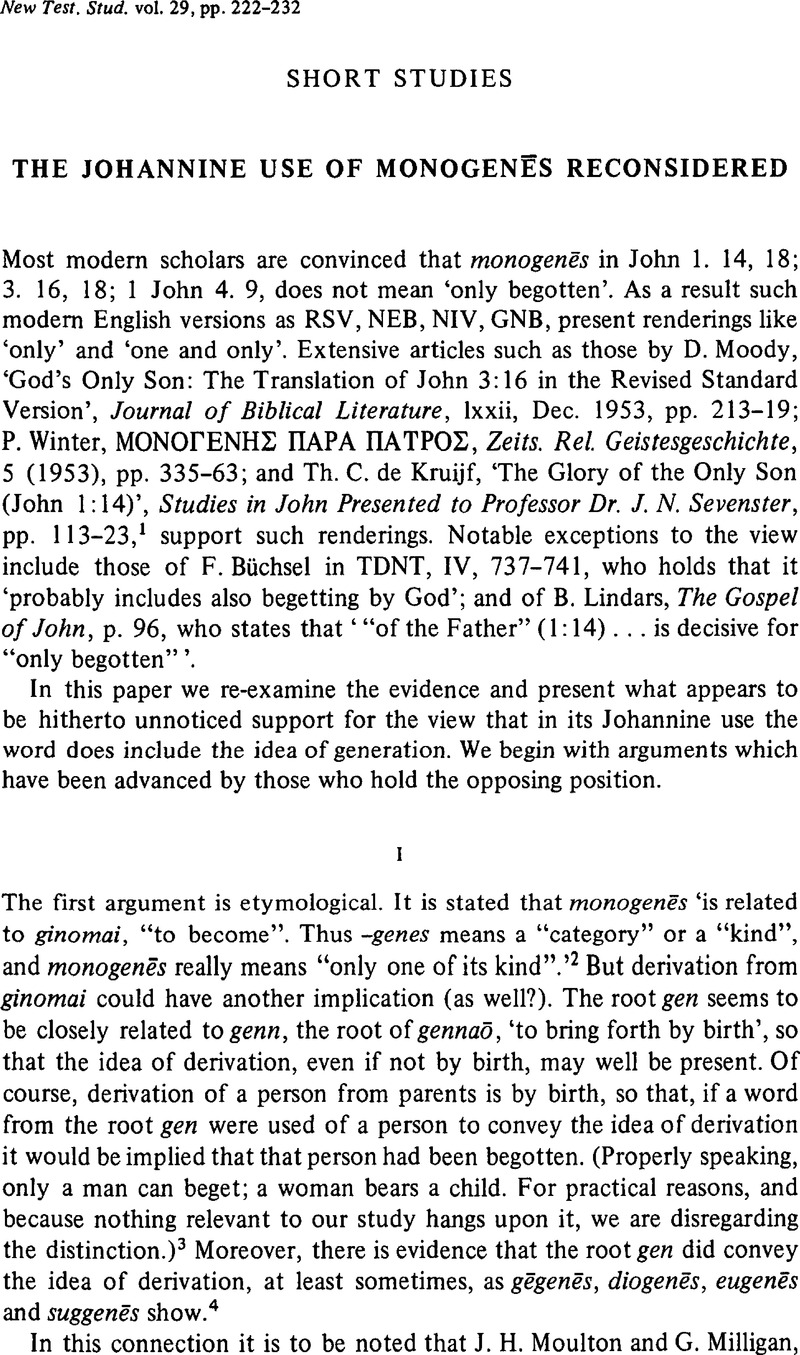Article contents
The Johannine Use of Monogenēs Reconsidered
Published online by Cambridge University Press: 05 February 2009
Abstract

Information
- Type
- Short Studies
- Information
- Copyright
- Copyright © Cambridge University Press 1983
References
NOTES
[1] See also Bultmann, R., The Gospel of John, pp. 71 ff. n. 2.Google Scholar
[2] Nida, E. A., Good News for Everyone, p. 64.Google Scholar
[3] Moody, D., loc. cit., p. 217, seems to overlook the fact that gennaō can have a female as well as a male for its subject.Google Scholar
[4] Cf. Büchsel, F. in TDNT, 4, 737–738.Google Scholar
[5] So also Westcott, B. F., The Epistles of St. John, Fourth Edition, p. 171 n. 2.Google Scholar
[6] E.g. Moody, D., loc. cit., pp. 217, 219.Google Scholar
[7] Qu. by Büchsel, in TDNT, 4, 738 n. 5.Google Scholar
[8] E.g. Moody, D., loc. cit., p. 217Google Scholar; Nida, E. A., op. cit., p. 64Google Scholar; Morris, L., The Gospel according to John, p. 105.Google Scholar
[9] See Winter, P., loc. cit., pp. 338 ff.Google Scholar, re ‘beloved’ as a translation of monogenēs.
[10] Trans. by J. W. Etheridge.
[11] Philo used the Old Testament in a Greek translation. Cf. Zöckler, O. in The New Schaff-Herzog Encyclopaedia of Religious Knowledge, 9, 41.Google Scholar
[12] For the rather considerable evidence of such a text, see Winter, P., loc. cit., pp. 337–8.Google Scholar
[13] This assumes with Wilckens, U. in TDNT, 7, 500 n. 219, that ‘σοøíα is expressly defined as πνεῡµα in Wis. 7:22 f.’ CfGoogle Scholar. Bieder, W. in TDNT, 6, 371 n. 188.Google Scholar
[14] R. Bultmann, loc. cit., states that any influence of this usage on the Fourth Gospel could only be ‘very indirectly, if there is a connection between it and the use of µονογ. as a cosmological attribute’. Bultmann's judgment is especially significant in view of the fact that he is prone to derive Johannine concepts and usages from Hellenistic sources.
[15] Jerome's revision of the New Testament was commissioned probably in 382. For evidence from this period that monogenēs means ‘only (begotten?)’ and not merely ‘unique’ and/or ‘beloved’, see Athanasius, Four Discourses Against the Arians, 2. xxi. 62Google Scholar; Gregory of Nyssa, Against Eunomius, 2, 7Google Scholar; II, 8; Cyril of Jerusalem, Lecture XI, 2.
[16] B. F. Westcott, op. cit., p. 171; Moody, D., loc. cit., pp. 214–16.Google Scholar
[17] See Moody, D., loc. cit., pp. 214–15.Google Scholar
[18] ‘The Private Creed of Arius’ qu. in Schaff, P., The Creeds of Christendom, 2, 28Google Scholar; see also Gregory of Nyssa, Against Eunomius, 2, 7.Google Scholar
[19] See n. 14.
[20] Moody, D., loc. cit., p. 214.Google Scholar
[21] Loofs, F. in The New Schaff-Herzog Encyclopaedia of Religious Knowledge, 5, 283.Google Scholar
[22] Because of Tob. 6. 14 B we doubt that B. Lindars, op. cit., p. 96, is correct when he states that para patros in John 1. 14 is decisive for ‘only begotten’.
[23] L. Morris, op. cit., p. 842. But see Moule, C. F. D., The Phenomenon of the New Testament, p. 110.Google Scholar
[24] Jesus Christ in the Old Testament, p. 110.
[25] Ibid., pp. 110–11.
[26] Cf. Blass, and Debrunner, , A Greek Grammar of the New Testament, p. 35Google Scholar; Robertson, A. T., A Grammar of the Greek New Testament in the Light of Historical Research, p. 226.Google Scholar
[27] Metzger, B. M., A Textual Commentary on the Greek New Testament, p. 719. The strength of this point may be diluted by the fact that in John 1. 13 (most witnesses) the aorist indicative passive is used of the believer.Google ScholarIbid. states that A* and B support the reading auton.
[28] See Scholer, D. M. in Current Issues in Biblical and Patristic Interpretation (Edited by Hawthorne, G. F.), p. 245 n. 72, for a fuller discussion of this matter.Google Scholar
[29] That Christ is called ‘Son of God’ could be derived from 2 Sam. 7. 14. Cf. 1 En. 105. 2; 4 Ezra 7. 28 f.; 13. 52; 14. 9. John 20. 29 is reminiscent of Ps. 2. 12 LXX but it is doubtful that it is dependent thereon. (Cf. Barrett, C. K., The Gospel according to John, p. 477)Google Scholar. Dodd, C. H., The Interpretation of the Fourth Gospel, p. 271Google Scholar, suggests that the use of gennaō in John 1. 13 may owe something to Jewish interpretation of Ps. 2. 7 as referring to the true Israel. (Cf. Howard, W. F., Christianity according to St. John, p. 198Google Scholar.) In our opinion the fact that the tekna of God are being described, whereas Ps. 2 speaks of the huios of God, a term our author reserves for Christ, tells against any conscious dependence on Ps. 2.
- 1
- Cited by

